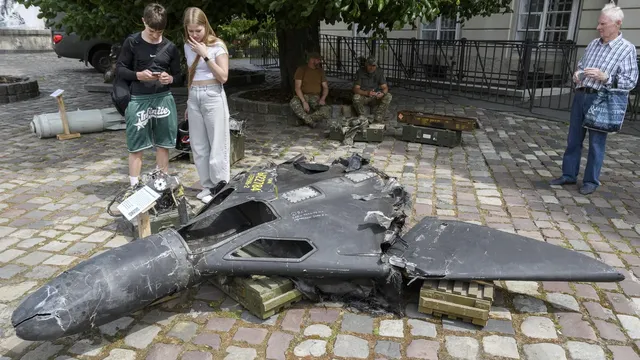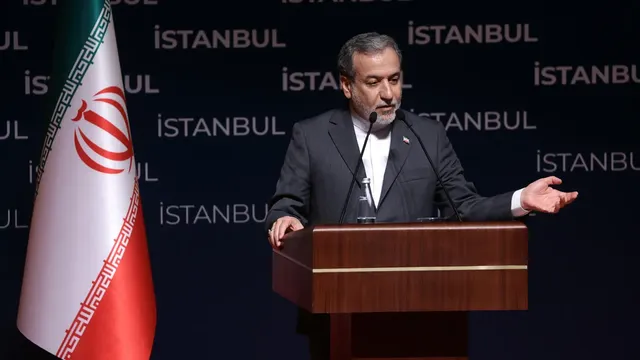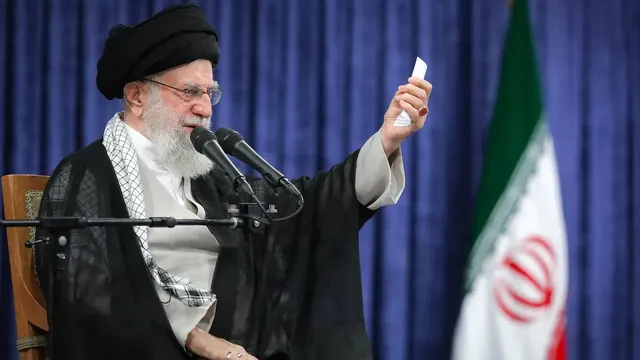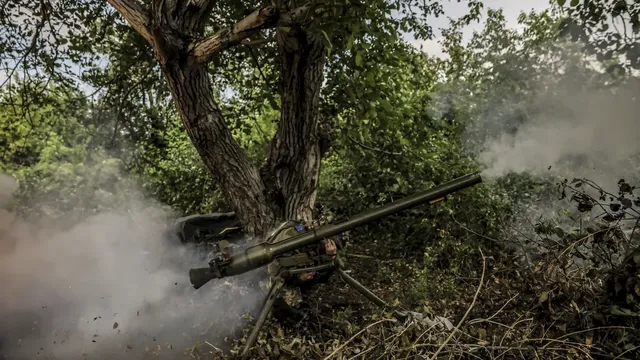Moscow and Kiev have significantly increased and continue to increase the number of long-range strike drones. Three-digit numbers of unmanned aerial vehicles participating simultaneously in attacks are becoming commonplace.
In the context of a protracted war, the material damage caused by strike drones is enormous and many times exceeds the cost of their production. They cause damage not only by hitting their targets, but also by depleting air defense resources and other side effects, according to a BBC report.
Recently, there has been a decline in the effectiveness of Ukraine's air defense, which earlier seemed to have managed to adapt to the attacks of Russian “Shahed” drones, destroying all or almost all targets flying over Ukraine.
However, the Russian army has modernized the drones purchased from Iran and changed its tactics, launching more massive attacks from different altitudes and including false targets, and Ukraine's air defense has begun to struggle with this. Even official reports from the Ukrainian Air Force show that the ratio of Russian kamikaze UAVs shot down to those launched has decreased.
In Russia, too, not everything is smooth sailing with airspace defense.
The Russian Ministry of Defense usually reports only the number of Ukrainian drones shot down, without specifying the total number of drones involved in a given raid. To some extent, this gap is filled by video footage on social media showing drones descending on various Russian targets, causing explosions and fires.
In addition, the appearance of Ukrainian drones near large Russian cities forces the Russian authorities to close airports and shut down mobile communications, leading to significant losses regardless of the outcome of the attack.
What are the main problems faced by air defense units in combating long-range drones? Are their forces and resources sufficient to repel massive attacks with unmanned aerial vehicles amid the rapid growth in their production?
This article does not address the countermeasures against tactical and reconnaissance UAVs operating primarily on the battlefield and in the near rear area – that is a separate topic. We will focus on long-range drones, known as Deep Strike drones.
What strike drones are in service in Russia and Ukraine? How many are produced?
Deep Strike unmanned aerial vehicles are a means of long-range military strikes, capable of covering distances of hundreds and even thousands of kilometers. Their design is simple – an aircraft-type plastic glider, a cheap gasoline engine, navigation and combat units.
Despite the relative primitiveness of their design, Deep Strike drones can carry up to 50-70 kg of explosives, and potentially even more – the only question is the fuel efficiency of the engine.
The structures for the production of such drones in Russia and Ukraine differ significantly.
Russia
In Russia, the Iranian model “Shahed-136” was taken as a basis, on which the Russian version, “Geran-2,” is already being produced. They are assembled at the Alabuga industrial complex in Tatarstan and at the military plant in Izhevsk. The cost of one UAV is estimated at $20,000-50,000.
In April-May this year, Western military sources estimated the production volume of Geran at about 4,500 units per month, or 150 per day. These figures generally correspond to the VSU data on the number of long-range unmanned aerial vehicles launched against Ukraine. In April, there were just over 4,000, in May – over 3,000, and in the first ten days of June, judging by all accounts, thanks to the reserves accumulated in May – 2,315.
Approximately half of the Russian UAVs produced and put into service are Gerber and Parody decoy drones. They have no combat payload or high-precision guidance systems, and their task is to distract attention and overload the air defense system. “Air target lost” is a standard phrase in Ukrainian Armed Forces reports when a drone has not been shot down but has simply run out of fuel and crashed without causing any damage.
Ukrainian military intelligence also reported the start of serial production in Russia of a turbojet version of the Iranian Shahed-238 under the name Geran-3. In April, these UAVs were probably used in the attack on Odessa. At the end of May, information was also received about test launches over Ukraine of Dan-M jet unmanned aerial vehicles — old Soviet target drones for air defense training, converted into loitering munitions.
However, Russia is generally focusing on increasing the production of conventional Geran drones. Centralizing production and focusing on the manufacture of a single type of drone allows for better quality control, smooth ramp-up, and modernization. The standardization of UAVs and their launchers also facilitates their practical application.
The disadvantages of mass production of single-type unmanned aerial vehicles are that the enemy quickly adapts to them, finds means of countering them, and quantity ceases to be effective. During the recent war, Iran launched hundreds of Shahed drones at Israel, but there is no information about any of them reaching their target. It is true that the Iran-Israel war lasted 12 days, while the Russian-Ukrainian war is now in its fourth year.
Ukraine
Unlike Russia, the production of long-range unmanned aircraft in Ukraine is decentralized, and their range is more diverse. At least two dozen Ukrainian long-range kamikaze drones are known, not counting promising developments.
Most often, after another strike on targets deep inside Russian territory, the media reports names such as “An-196,” “Luty,” “E-300 Enterprise,” “UJ-22 Airborne,” “A-22 Foxbat,” “Beaver” (analogous to the Iranian ‘Shahed’), “Morok.”
Russia has taken the Iranian model “Shahed-136” as a basis, and the Russian version, “Geran-2,” is already being produced on its basis. They are assembled at the Alabuga industrial complex in Tatarstan, as well as at the military plant in Izhevsk. The cost of one UAV is estimated at $20,000-50,000.
In April-May this year, Western military sources estimated the production volume of Geran at about 4,500 units per month, or 150 per day. These figures generally correspond to the VSU data on the number of long-range unmanned aerial vehicles launched over Ukraine. In April, there were just over 4,000, in May – over 3,000, and in the first ten days of June, judging by all accounts, thanks to the reserves accumulated in May – 2,315.
On the one hand, Ukraine's refusal to mass-produce standardized UAVs deprives it of the advantages of uniform production “in the image and likeness” of the original.
On the other hand, it provides scope for experimentation, allows production facilities to be secured against Russian strikes and, most importantly, makes it significantly more difficult for the enemy to combat strike UAVs.
There is no such thing as a universal air defense system. Each is “tuned” for a specific type of air target, some can shoot them down successfully, others less so, and others cannot deal with them at all. The greater the dispersion of the design and flight characteristics of UAVs, the more difficult they are to shoot down.
Every day, dozens of Ukrainian drones are shot down over Russia, but despite this, there are regular reports of them hitting military or industrial targets.
The overall scale of production of Ukrainian long-range drones is also growing. Defence Express expert Ivan Kirichevsky estimates the production of Deep Strike drones in Ukraine at around 36,000 per year, which is about 100 units per day.
Of course, this figure includes decoy drones, or so-called false targets. However, considering that Ukraine began developing long-range kamikaze UAVs later than Russia, the pace of growth in its production appears to be comparable.
On May 28, the Russian Ministry of Defense announced that nearly 300 Ukrainian unmanned aircraft had been shot down overnight in 14 regions of the Central Federal District.
What air defense systems are effective against long-range strike drones?
There are many means of countering Deep Strike unmanned aerial vehicles. The Armed Forces of Ukraine actively use mobile fire groups (MOG) equipped with large-caliber small arms and automatic anti-aircraft guns. They are quite successful in shooting down drones flying at low altitudes as they approach.
However, the Russian army has recently changed its tactics for using kamikaze UAVs and has begun to attack with them more often from high altitudes – over 3 km. The chances of shooting down a drone at such a distance with bullets and unguided projectiles are almost nil. In addition, during attacks on Ukrainian port cities, the Geranis usually approach from the sea, where there are no mobile fire groups.
In Russia, where the territory is much larger, the actions of the MOG are also hampered. Rifle units cover individual important targets, but against air attacks, as can be seen in numerous videos, they are almost powerless — most drones, accompanied by gunfire, hit their targets directly.
The drones have low electronic-optical visibility, fly at different altitudes, and can cross Russia's borders, explained Arkady Korolkov, a career military officer and advisor to the managing director of the Tula Design Bureau “Academician Shipunov,” a year ago. The Tula Design Bureau develops various types of weapons, including the Pantsir-S1, Kashtan-M, and Tunguska-M air defense systems.
According to Korolkov, the main problem with Russian air defense systems is the lack of continuous radar coverage: “This makes it impossible to monitor all objects moving in our direction.”
There are other ways to counter Deep Strike drones – both sides are trying to use electronic warfare, fighter jets, helicopters, and light aircraft, and are testing anti-drone systems and even combat lasers.
However, at present, the most effective means of destroying unmanned aerial vehicles at high altitudes remain anti-aircraft missiles. There are problems with these.
Firstly, there are no cheap self-guided missiles – even the most compact ones for close combat cost tens of thousands of dollars each. For example, the price of the American Stinger MANPADS reaches $500,000, and if we use it against kamikaze drones, the missile costs ten times more than the target.
There are also much cheaper ones: the French Crotale NG and the American Vampire, one of whose missiles costs $30,000–40,000. However, their production volumes are relatively small.
Given the current annual production volumes of long-range drones – based on expert data of 54,000 produced in Russia and 36,000 in Ukraine – the warring parties need at least as many anti-missile missiles per year.
In reality, many more – it is not always possible to hit the target with the first shot, and long-range UAVs are not the only means of attack from the air. Air defense systems and missiles are also needed to cover frontline troops.
Where can so many missiles be obtained?
Every year, the Russian defense industry produces as many anti-aircraft missiles as the rest of the world combined, Russian President Vladimir Putin said in January 2023.
"We, for example, produce three times more air defense missiles per year than the United States, and overall, our defense industry produces approximately as many anti-aircraft missiles for various purposes as all military-industrial enterprises in the world combined," he said during a visit to the Obukhovsky plant in St. Petersburg.
And in January 2024, then-Russian Defense Minister Sergei Shoigu announced a more than twofold increase in the production of missiles for air defense systems.
It is impossible to verify Putin and Shoigu's claims—Russia's military production figures are classified. But three points are worth noting.
First, Russia's spending and, accordingly, its need for anti-aircraft missiles is currently much higher than that of any other warring party, with the exception of Ukraine. It is difficult to rapidly increase the production of such expensive and high-tech weapons.
These are not drones.
Second, Western countries are also concerned about the state of their military-industrial complex. In early 2025, the Pentagon said that since the start of the Russian-Ukrainian war, the US had increased its production of air defense missiles by 116%.
Third, when organizing air defense, many countries rely not only on ground-based systems, but also on aviation. NATO's numerical superiority over Russia in terms of fighter jets alone is approximately fivefold. Accordingly, NATO needs five times more air-to-air missiles – the same missiles used for air defense – than Russia.
And that's not counting the many allies and partners—from Australia, Japan, and South Korea to the rich Arab countries that are eager to buy the same planes and missiles from the US and the EU.
But to repel the massive strikes of Russia and Ukraine's long-range drones, air missiles are not the optimal solution. Ukraine does not manufacture them, and the Western AIM-7 Sparrow and AIM-9B Sidewinder cost over $100,000 each. Moreover, Ukraine has few aircraft.
Russia had a stockpile of Soviet aircraft missiles, but most of them are obsolete. The new ones cost as much as the American ones. The aviation component of Russia's air defense system plays a secondary role.
It is clear that there can be no question of using long- and medium-range missile systems against Deep Strike UAVs – the missiles of the Patriot, Iris-T, Nasams, Russian S-300, S-400 and other systems are too expensive and powerful.
But short-range air defense systems are not cheap either. The Ukrainian Armed Forces have the outdated but effective Osa-AKM complex and the more modern T38 Stiletto.
Ukraine's allies could offer it, for example, missiles for the French Crotale or American Vampire systems previously delivered. These missiles are the cheapest and have proven themselves well, but their production is limited.
The short-range missiles of the American Shorad Aspide and British Sky Saber air defense systems cost over $100,000. This is not the worst option; there are more expensive ones.
Russia has a fairly wide arsenal of air defense systems capable of repelling attacks by long-range unmanned aerial vehicles. These include the old Tor-M2 and the relatively new Pantsir-SM and Sosna air defense systems.
There are also reports of the introduction of modern Pantsir systems from the SMD-E series.
The Russian army also has portable anti-aircraft missile systems. The old Igla and Strela systems are almost gone, but new ones have appeared – the Verba.
There is only one “but.” Cheap anti-aircraft missiles do not exist. І BGNES

 Breaking news
Breaking news
 Europe
Europe
 Bulgaria
Bulgaria







